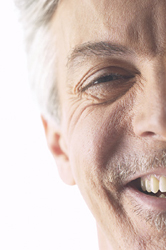What REALLY Makes Your Hair Turn Gray?
(And is Stress a Major Factor?)
by www.SixWise.com
It happens to just about every U.S. President as they struggle through their term in office, and it reportedly happened to Marie Antionette in the days before she was guillotined. Of course, just about every parent of a teenager (or a 2-year-old, for that matter) has likely experienced it too: Gray hair!
|

You may not be able to blame your gray hair on your teenaged children and demanding job after all!
|
Yet, contrary to the old wive’s tale that stress will make your hair turn gray, scientific studies showing such a link are lacking. Rather than the emotional stress we often associated with premature gray, a new study in the journal Cell found that cell stress may be a more likely cause.
DNA Damage May Color Your Hair Gray
Researchers from Tokyo Medical and Dental University found that cellular stress, caused by damaging agents like chemicals, ultraviolet light and ionizing radiation, may explain why your hair turns gray.
As the study’s lead author, Emi Nishimura, pointed out, a single cell may encounter up to 100,000 events a day that damage DNA, and stem cells in your hair follicles responsible for color are impacted by this damage.
While you’re young, stem cells in your hair either reproduce or mature into more specialized cells that produce pigment to color your hair. But as you age, too many stem cells mature until there are no pigment cells left to be added to your hair.
The researchers believe that accumulated DNA damage may be the trigger that causes stem cells to mature, which then allows these damaged cells to be purged.
While the researchers said the DNA damage your hair cells experience is largely “unavoidable,” they did offer hope that anti-graying creams that prevent your hair’s stem cells from switching roles may one day be available.
Is Hydrogen Peroxide Also a Culprit?
|
Get Naturally Clean, Fresh Hair No Matter What the Color With Enviro-Rite Hair-Body Wash

Hair-Body Wash is a non-irritating, soy-based personal cleansing product suitable for use on both body and hair. Soy -- nature's versatile, renewable harvest -- is the cream of the crop among cleansers, natural or otherwise. Hair-Body Wash cleans beautifully, gently and is a wonderful moisturizer!
Reasons to Choose Hair-Body Wash:
-
Free of petroleum-based ingredients, fragrances, dyes and other common triggers for respiratory or skin irritations.
-
Designed by and for people with allergies, asthma and chemical sensitivities.
-
Very economical -- dual use for both hair and body!
-
Gives extra body to fine hair
-
Makes a great bubble bath
-
So gentle -- it's great for children too!
-
Earth friendly -- safe to take camping, non-toxic, breaks down safely and rapidly.
-
No animals were used in the testing of this product.
|
A separate study by researchers at the University of Bradford in the United Kingdom found another reason why your hair turns gray: hydrogen peroxide.
We’re not talking about the kind used to turn your hair bleach blonde, but rather the type that is produced naturally in your body.
This hydrogen peroxide interferes with melanin, the pigment that colors your hair (and skin). When you’re young your body produces the enzyme catalase, which breaks down hydrogen peroxide and protects your hair color. But as you get older you make less catalase, and the hydrogen peroxide is free to “bleach” out your color.
Further, hair follicles of gray-haired people also contain fewer hair-repair enzymes, which also suppresses the production of melanin.
The researchers believe products that remove hydrogen peroxide from your hair and body may one day help people to avoid going gray.
Beware of Using Hair Color to Cover up Gray
You may be tempted to cover up your gray using one of the many hair color brands on the market, but if you do so be sure to do your research first.
Many of them, particularly the darker colors, contain coal tar ingredients that have been linked to cancer in some studies.
In fact, about 400 out of the 456 hair colors ranked at the Skin Deep cosmetics database of the Environmental Working Group are considered high hazard! This means they may contain ingredients linked to:
If you decide you must cover up your gray, be aware that semi-permanent and temporary colors are generally less toxic than permanent color, and darker shades are generally more toxic than blonde and red shades. When choosing a color, either seek out a chemical-free, herbal hair salon or choose at-home colors made from henna, herbal dyes, vegetable dyes and other food-based ingredients.
Recommended Reading
Healthy Hair--You've Heard the Phrase 10,000 Times, but What Exactly IS Healthy Hair?
Hot Peppers Help Stimulate Hair Growth (Among their Other Benefits!)
Sources
Cell 2009 Jun 12;137(6):1088-99.
National Geographic June 16, 2009
MSNBC.com March 2, 2009
The FASEB Journal. 2009;23:2065-2075.
Environmental Working Group September 17, 2007